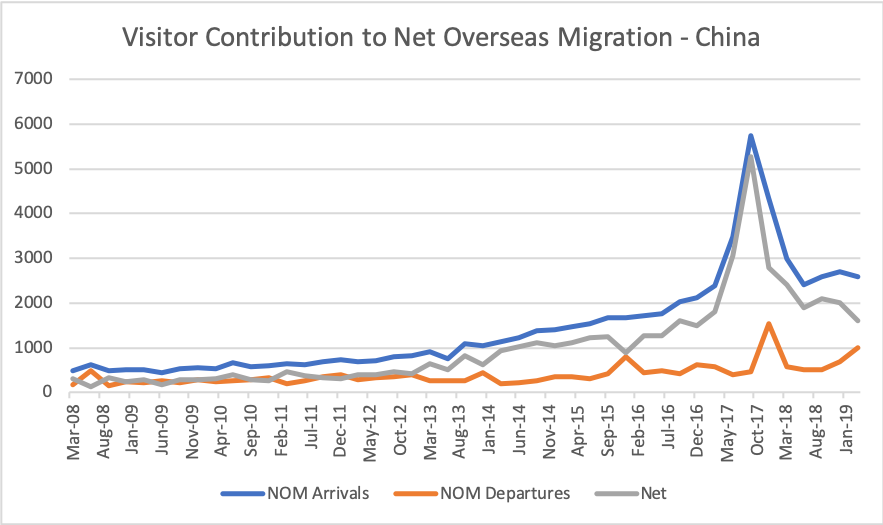David Crowe in the Sydney Morning Herald reports that Dutton’s Department received an average of 77 asylum applications per day in November 2019. That brings the total number of asylum applications in the last five and a half years to well over 100,000. But what is happening to those 100,000 people?
According to Immigration Minister David Coleman, there were 2,316 new asylum applications in November 2019 and 1,391 applications were finalised at the primary stage. In other words, the size of the primary stage backlog increased by 925 in November 2019. Of the 1,391 finalisation, 1,248 were refused a protection visa (ie around 90 percent).
The total number of refugee status determinations awaiting a decision at the Department of Home Affairs at end of November 2019 was 35,445. Coleman’s report states the total number of individuals that were not granted a Final Protection visa that have yet to be deported at the end of November 2019 was 46,142. This number includes asylum seekers who have appealed to the AAT or are seeking judicial review. This cohort number appears to be growing at around 1,000 per month.
In November 2019, a paltry 25 unsuccessful asylum seekers were ‘deported’ according to Coleman – 24 voluntarily and one involuntarily. The Department of Home Affairs simply does not have the resources to locate, detain and remove the rapidly growing number of unsuccessful asylum seekers (and it is highly unlikely it will ever have the extraordinary level of resources needed).
Net Overseas Migration and Population Impact
It is now clear Australia will join the USA and Europe and have a rapidly growing and very large cohort of unsuccessful asylum seekers. It is worth noting that in 2018-19, asylum seekers contributed around 10.5 percent to net overseas migration. In that year, they contributed more to net overseas migration than the whole of the offshore Humanitarian Program.
As net overseas migration declines, as it currently is, the comparative contribution of asylum seekers to net overseas migration will rise if these numbers remain at current levels in absolute terms.
Asylum seekers represented around 6.5 percent of Australia’s total population growth in 2018-19.
Dutton has said this issue is a ‘red herring’. And as Pezzullo remains in denial, at least publicly, there is little to no prospect of Government getting on top of the issue.
That means Australia will have a growing cohort of unsuccessful asylum seekers with no work rights, no access to social support and no access to Medicare. They will need to survive by undertaking work in the black economy, constantly subject to abuse and exploitation. They will be living in the fear that Home Affairs will suddenly arrive to deport them or that they will be dobbed-in – even though the chances of either is highly remote.
Many will form relationships, including with other asylum seekers and some with Australians. Some will have children. Does Dutton propose those people, and their children, will be treated the way he has treated the family from Biloela?
China – A Case Study
There has been much discussion of the surge in asylum seekers from Malaysia as that has used a very old scam linked to the Electronic Travel Authority and slow visa processing in Australia after arrival. There has not been as much focus on the surge out of China.
Visitor visa processing out of China until February 2017 had a substantial human involvement. From February 2017, Pezzullo introduced what appears to be mandatory electronic lodgement and auto-grant. Under this arrangement, if an application meets various characteristics as determined by the ‘Global Integrity System’, the visa would be granted by the system rather than by a human (see here).
It is thus no coincidence that the rapid increase in asylum applications from Chinese nationals came soon after as reflected in the Chinese visitor contribution to net overseas migration in the chart below. While electronic lodgement and auto-grant are options worth exploring, they must be implemented with care and caution. Pezzullo appears to have rushed implementation, perhaps to save money and/or his general disregard for the work of visa processing staff.

Source: Customised Data Supplied by ABS
While Pezzullo pretends nothing can be done about the increase in asylum applications, it is clear instructions have been given to increase scrutiny of visitor applications from Chinese nationals. General tourist visa grant rates have fallen from 95.6 percent in the June quarter of 2017 (ie the quarter after introduction of mandatory electronic lodgement and auto-grant) to 88.6 percent in the June quarter of 2019.
That means a seven percentage point increase in the number of tourist applications refused. Given the size of the Chinese tourist visa caseload (almost a million applications per annum), this is no minor change.
Similarly, grant rates for business visitors from China have declined from 96.4 percent in the June quarter of 2017 to 92.6 percent in the June quarter of 2019.
In other words, Pezzullo’s bungled implementation of electronic lodgement and auto-grant has not only dramatically reduced the integrity of Australia’s visa system, with a massive cost to the Budget, but it is also costing Australia’s tourism industry.
How much longer can the Government allow this level of incompetence to go on?
Abul Rizvi was a senior official in the Department of Immigration from the early 1990s to 2007 when he left as Deputy Secretary. He was awarded the Public Service Medal and the Centenary Medal for services to development and implementation of immigration policy, including in particular the reshaping of Australia’s intake to focus on skilled migration. He is currently doing a PhD on Australia’s immigration policies.




